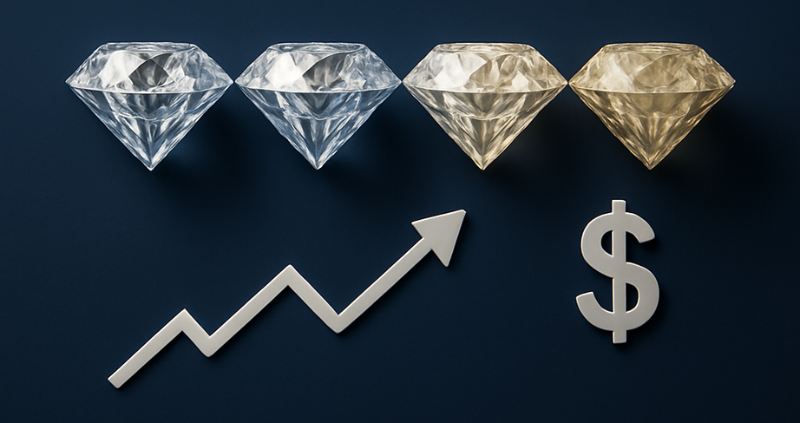Colour Grading Demystified: How Subtle Hues Impact Diamond Pricing

When it comes to buying a diamond, most people focus on size and sparkle. But there’s one factor that plays a huge role in pricing—and it’s often overlooked. We’re talking about colour.
Yes, even the slightest tint of yellow or brown can bump a diamond's price up or down. And no, we're not talking about fancy-coloured diamonds like blue or pink—we mean the subtle shades you may not even notice unless you know what to look for.
So let’s dig into the world of diamond colour grading and see how it really affects what you pay.
What is Diamond Colour Grading?
Diamond colour grading is all about how colourless a diamond is. The more colourless it appears, the higher its value. Most diamonds used in jewellery are graded on a scale from D to Z by institutions like the GIA (Gemological Institute of America).
Here’s a quick breakdown:
- D-F: Colourless
- G-J: Near Colourless
- K-M: Faint Colour
- N-Z: Noticeable Colour
The differences between these grades can be super subtle—sometimes even invisible to the untrained eye. But to professionals, and in terms of pricing, these differences matter a lot.
Why Does Less Colour Mean More Money?
Diamonds that are truly colourless (D-F) are rare. And like anything rare, they cost more.
- A D-grade diamond has absolutely no colour and reflects light brilliantly.
- A G or H-grade diamond might show a tiny bit of warmth under close inspection, but still looks great—especially in a white gold or platinum setting.
- Lower grades like K or L can show noticeable yellowish tones, which some buyers may find less attractive.
So even if two diamonds are the same size and clarity, the one with better colour will likely cost hundreds or even thousands more.
How Colour Affects Your Jewellery Choice
Here’s where things get interesting—not every buyer needs a D-grade diamond. In fact, depending on the setting and shape, you might not notice the difference at all.
- Yellow gold settings can make a lower colour grade diamond look whiter.
- Round brilliant cuts reflect more light and can hide colour better than shapes like emerald or oval.
- If you're on a budget, going for a G-H or even I-J colour grade can help you save without sacrificing beauty. Smart tip: Instead of paying top dollar for a D colour, consider investing that money into size or clarity instead—especially if the colour difference won’t be visible once it’s set.
Real-World Price Differences
Let’s say you’re choosing between two 1-carat diamonds:
- Diamond A: 1.00 carat, D colour, VS1 clarity – £8,000
- Diamond B: 1.00 carat, G colour, VS1 clarity – £6,000
They’re both stunning, but that subtle colour drop could save you £2,000—money you could put toward a custom setting or another piece of jewellery.
Does Colour Grading Affect Resale Value?
Yes, it can. Diamonds with better colour grades generally hold better value over time, especially for investment or resale purposes. However, most jewellery is bought for personal enjoyment, not profit—so don't overthink it if you're buying for yourself or a loved one.
Conclusion: The Truth About Colour
In the world of diamonds, colour isn’t just about looks—it’s a major player in pricing. But here’s the truth: you don’t always need the top grade to get a beautiful stone. Understanding the colour scale helps you shop smarter and maybe even save a good chunk of money.
So the next time you’re choosing a diamond, take a close look at its colour grade. Ask your jeweller to show you stones side by side—and see for yourself how much (or how little) difference a few grades make.

